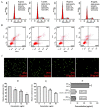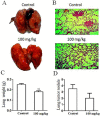The paradigm-shifting idea and its practice: from traditional abortion Chinese medicine Murraya paniculata to safe and effective cancer metastatic chemopreventives
- PMID: 26959747
- PMCID: PMC5008316
- DOI: 10.18632/oncotarget.7932
The paradigm-shifting idea and its practice: from traditional abortion Chinese medicine Murraya paniculata to safe and effective cancer metastatic chemopreventives
Abstract
Recent large epidemiological studies demonstrated benefit of oral contraceptives in reducing cancer risk, and our analysis also showed molecular and cellular similarities between embryo implantation and CTCs adhesion-invasion to endothelium. We here hypothesize that abortion traditional Chinese medicine (TCM) may serve well for pre-metastatic chemoprevention. To test the hypothesis, we selected the safe and well-known abortifacient TCM Murraya paniculata and identified a most-promising extracted fraction G (containing flavonoids and coumarins) from its many raw ethanol/dichloromethane extracts by using the bioactivity-guided fast screen assay. G showed free radical scavenging effect, and specifically inhibited both embryo implantation to human endometrial bed and cancer HT29 cells to human endothelium in a concentration-dependent manner (1-30 μg/mL) without significant cytotoxicity demonstrated by its high adhesion inhibition ratio. The inhibition may result from its down-regulation on expression of integrin β1 and α6, and CD44 on HT29 cells, as well as E-selectin on endothelial cells. Furthermore, G inhibited invasion and migration of HT29 cells. Pretreatment followed by one-month oral administration of G to the immunocompetent mice inoculated with mouse melanoma cells produced significant inhibition on lung metastasis without marked side effects. Collectively, this paradigm-shifting study provides, for the first time, a new strategy to discover safe and effective pre-metastatic chemopreventives from abortion TCM.
Keywords: Murraya paniculata; cancer metastatic chemoprevention; cell adhesion molecules; circulating tumor cells; traditional abortion Chinese medicine.
Conflict of interest statement
The authors have no other relevant affiliations or financial involvement with any organization or entity with a financial interest in or financial conflict with the subject matter or materials discussed in the manuscript apart from those disclosed.
Figures







Similar articles
-
Warfarin and coumarin-like Murraya paniculata extract down-regulate EpCAM-mediated cell adhesion: individual components versus mixture for studying botanical metastatic chemopreventives.Sci Rep. 2016 Aug 2;6:30549. doi: 10.1038/srep30549. Sci Rep. 2016. PMID: 27480614 Free PMC article.
-
Bioactivity-guided fast screen and identification of cancer metastasis chemopreventive components from raw extracts of Murraya exotica.J Pharm Biomed Anal. 2015 Mar 25;107:341-5. doi: 10.1016/j.jpba.2015.01.023. Epub 2015 Jan 19. J Pharm Biomed Anal. 2015. PMID: 25645338
-
A Flavonoid Glycoside Compound from Murraya paniculata (L.) Interrupts Metastatic Characteristics of A549 Cells by Regulating STAT3/NF-κB/COX-2 and EGFR Signaling Pathways.AAPS J. 2017 Nov;19(6):1779-1790. doi: 10.1208/s12248-017-0134-0. Epub 2017 Aug 25. AAPS J. 2017. PMID: 28842850
-
Similarities and differences between embryonic implantation and CTC invasion: Exploring the roles of abortifacients in cancer metastasis chemoprevention.Eur J Med Chem. 2022 Jul 5;237:114416. doi: 10.1016/j.ejmech.2022.114416. Epub 2022 Apr 26. Eur J Med Chem. 2022. PMID: 35500473 Review.
-
Diversity in Phytochemical Composition and Medicinal Value of Murraya paniculata.Chem Biodivers. 2023 Feb;20(2):e202200396. doi: 10.1002/cbdv.202200396. Epub 2023 Jan 19. Chem Biodivers. 2023. PMID: 36529712 Review.
Cited by
-
Cancer metastasis chemoprevention prevents circulating tumour cells from germination.Signal Transduct Target Ther. 2022 Oct 2;7(1):341. doi: 10.1038/s41392-022-01174-w. Signal Transduct Target Ther. 2022. PMID: 36184654 Free PMC article. Review.
-
Escins Isolated from Aesculus chinensis Bge. Promote the Autophagic Degradation of Mutant Huntingtin and Inhibit its Induced Apoptosis in HT22 cells.Front Pharmacol. 2020 Feb 25;11:116. doi: 10.3389/fphar.2020.00116. eCollection 2020. Front Pharmacol. 2020. PMID: 32158393 Free PMC article.
-
Warfarin and coumarin-like Murraya paniculata extract down-regulate EpCAM-mediated cell adhesion: individual components versus mixture for studying botanical metastatic chemopreventives.Sci Rep. 2016 Aug 2;6:30549. doi: 10.1038/srep30549. Sci Rep. 2016. PMID: 27480614 Free PMC article.
-
Inhibitory effects of isocryptotanshinone on gastric cancer.Sci Rep. 2018 Jun 18;8(1):9307. doi: 10.1038/s41598-018-27638-0. Sci Rep. 2018. PMID: 29915371 Free PMC article.
-
Mifepristone inhibits ovarian cancer metastasis by intervening in SDF-1/CXCR4 chemokine axis.Oncotarget. 2017 Jul 17;8(35):59123-59135. doi: 10.18632/oncotarget.19289. eCollection 2017 Aug 29. Oncotarget. 2017. PMID: 28938623 Free PMC article.
References
-
- Alix-Panabieres C, Pantel K. OPINION Challenges in circulating tumour cell research. Nat Rev Cancer. 2014;14:623–631. - PubMed
-
- DeSantis CE, Lin CC, Mariotto AB, Siegel RL, Stein KD, Kramer JL, Alteri R, Robbins AS, Jemal A. Cancer treatment and survivorship statistics, 2014. CA Cancer J Clin. 2014;64:252–271. - PubMed
-
- Perret GY. Pharmacological strategies and micrometastasis: what is known? What must be done? Minerva Med. 2010;101:163–178. - PubMed
MeSH terms
Substances
LinkOut - more resources
Full Text Sources
Other Literature Sources
Miscellaneous

